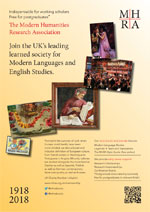MHRA Style Citation Demonstration
Click cover to enlarge | According to the MHRA Style Guide, this item should be cited in a bibliography as follows: Bassnett, Susan. 2020. ‘Crossing Textual Boundaries: Why Translation Matters’, in The MHRA Centenary Lectures, ed. by Graham Nelson (MHRA), doi:10.59860/cl.c7c505c This is in the author-date variant of MHRA style. MHRA's journals don't allow author-date citation, but some of its book series (notably Legenda) do: please talk to your editor before using this. (To see the demonstration for regular style instead, follow this link.) Let's take this bibliography entry one step at a time: Step 1. We start with the name(s) of the author(s) of the article, inverting the first name into the form 'Forename, Surname'. Bassnett, Susan Step 2. In author-date style, we have a full stop, then the year, then another full stop. If there are multiple entries with the same author and year, letters would be used to distinguish them: e.g., Bloggs 1994a, Bloggs 1994b. Bassnett, Susan. 2020. Step 3. Now we add the title, in single inverted commas. Any single quotation marks already in the title must be converted to doubles. Bassnett, Susan. 2020. ‘Crossing Textual Boundaries: Why Translation Matters’ Step 4. We have to say where this comes from, so: Bassnett, Susan. 2020. ‘Crossing Textual Boundaries: Why Translation Matters’, in Step 5. Next we identify where the article is to be found, using italics, not quotation marks, for the volume title. Bassnett, Susan. 2020. ‘Crossing Textual Boundaries: Why Translation Matters’, in The MHRA Centenary Lectures Step 6. After the title come any editors or translators. It's 'ed. by', not 'ed by', because although 'ed.' abbreviates 'edited', we regard the 'd' as the second letter of 'edited', not the last: so the abbreviation doesn't contain the last letter, and thus must have a full stop '.' Bassnett, Susan. 2020. ‘Crossing Textual Boundaries: Why Translation Matters’, in The MHRA Centenary Lectures, ed. by Graham Nelson Step 7. Since this is a book, not a journal issue, we have to identify its source, in round brackets. Until 2024, MHRA style required a place of publication - for example, New York or Oxford. This is no longer given except in special circumstances. Bassnett, Susan. 2020. ‘Crossing Textual Boundaries: Why Translation Matters’, in The MHRA Centenary Lectures, ed. by Graham Nelson ( Step 8. Now a colon, a space, and the publisher's name. Abbreviating to 'MHRA' is fine here. Bassnett, Susan. 2020. ‘Crossing Textual Boundaries: Why Translation Matters’, in The MHRA Centenary Lectures, ed. by Graham Nelson (MHRA Step 9. Since we had the date of first publication up front, we don't need it here, so we're done with the bracketed part. Bassnett, Susan. 2020. ‘Crossing Textual Boundaries: Why Translation Matters’, in The MHRA Centenary Lectures, ed. by Graham Nelson (MHRA) Step 10. This contribution has a DOI, so the Fourth Edition Guide (2024) requires us to quote it, like so. Bassnett, Susan. 2020. ‘Crossing Textual Boundaries: Why Translation Matters’, in The MHRA Centenary Lectures, ed. by Graham Nelson (MHRA), doi:10.59860/cl.c7c505c And that's the finished bibliography entry. Note that there's no final full stop. So how about citations in the main text, or in footnotes or endnotes? The advantage of the author-date system is that these are very concise. In fact, you don't need a note at all. Suppose we quote from page 21: The author reminds us of Shakespeare’s view: ‘Better a foolish wit than a witty fool’ (Bassnett 2020: 21). And notes are concise too. There's no difference in how to treat the first and subsequent notes. 34 Bassnett 2020. So is author-date easier than regular MHRA style? Not always. Firstly, it may not be allowed by your editor, so check before using. But secondly, it makes books easier to write, but only at the cost of making them harder to proof-read. If you discover at the last moment that Blenkinsop 1996 was actually published in 1995, that can mean hundreds of corrections to make, and it gets worse if an author has many publications in the same year, because Blenkinsop 1996e and Blenkinsop 1996d are easy to confuse. |
